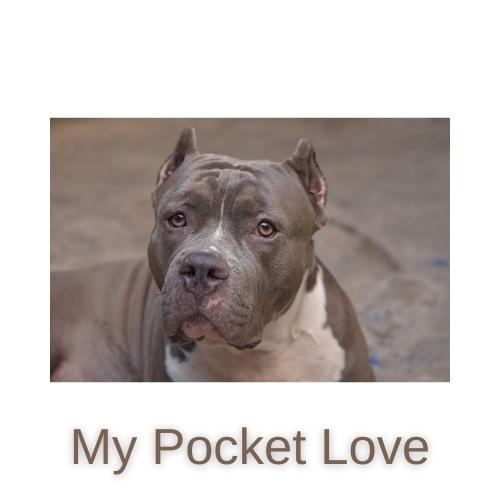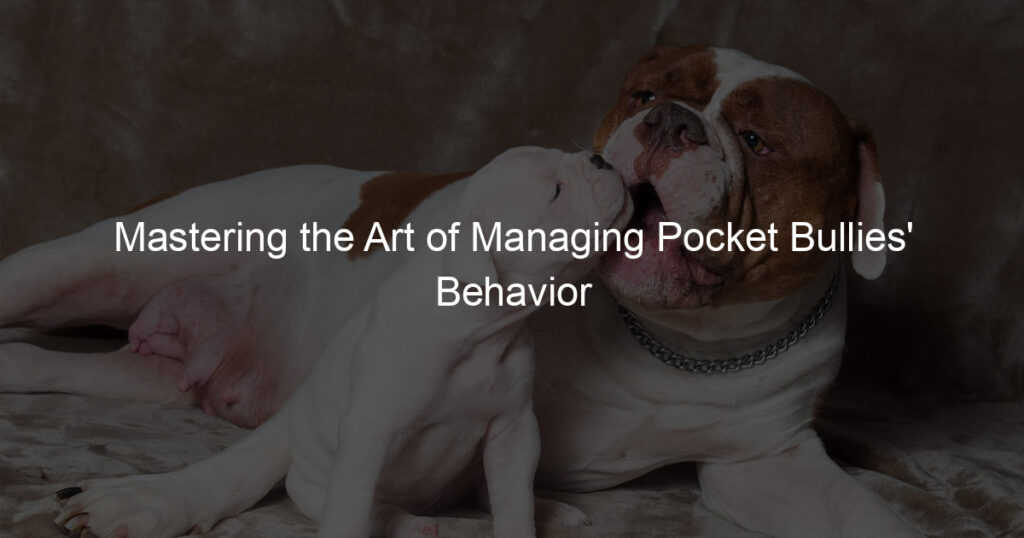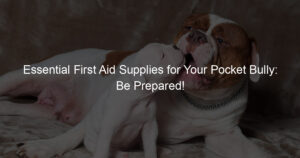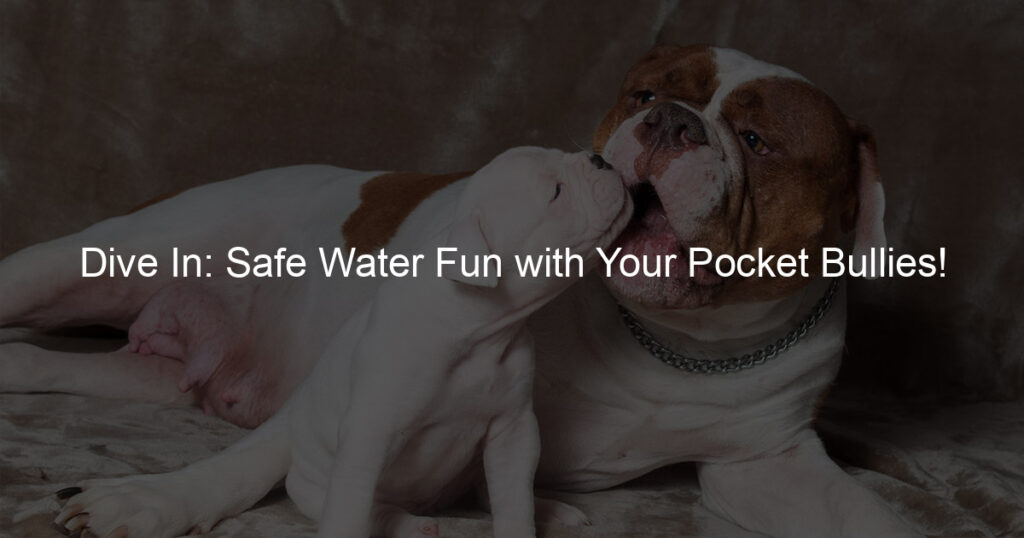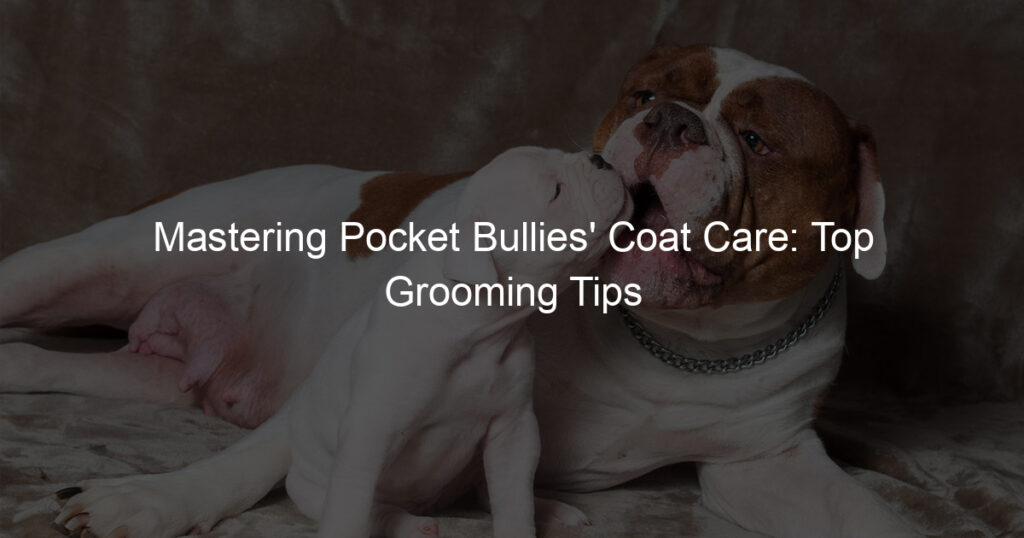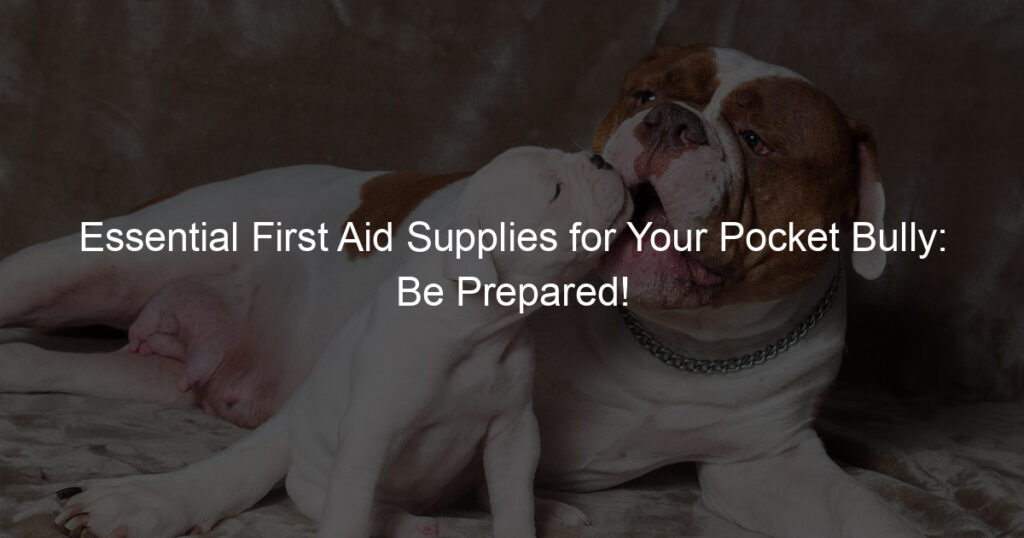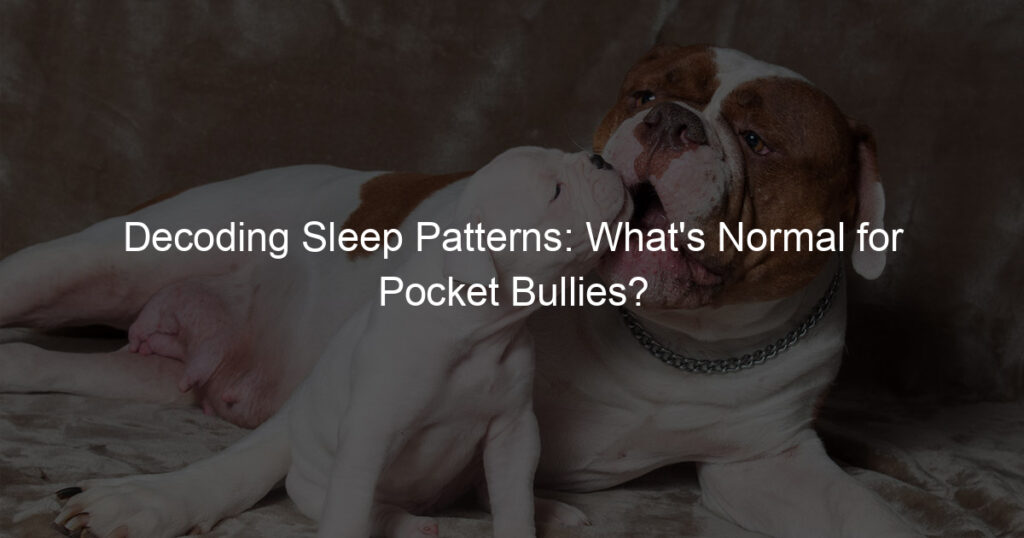
Introduction to Pocket Bullies Behavior Problems
As a dog owner or a potential dog owner, it is important to understand the breed of your dog and the common behavior issues associated with it. This knowledge will help you manage your dog’s behavior effectively and ensure a harmonious relationship. In this article, we will focus on the Pocket Bullies breed.
- Understanding the breed
- Common behavior issues in Pocket Bullies
- Stubbornness: Pocket Bullies can be stubborn at times, which can make training a bit challenging. Consistency and patience are key when dealing with this behavior.
- Aggression: While they are generally friendly, Pocket Bullies can show signs of aggression if not properly socialized or if they feel threatened.
- Destructive behavior: If they are bored or anxious, Pocket Bullies may resort to destructive behaviors such as chewing on furniture or digging holes.
Pocket Bullies, a type of American Bully, are known for their muscular build, short stature, and friendly nature. Despite their tough appearance, they are generally affectionate and good-natured dogs. They are intelligent, which makes them highly trainable, but their stubbornness can sometimes pose a challenge.
These dogs require a lot of physical activity and mental stimulation to keep them happy and healthy. Without these, they can become bored and may develop behavior problems. Understanding their needs and characteristics is the first step towards managing their behavior.
Like any other breed, Pocket Bullies can exhibit a range of behavior issues. Some of the most common ones include:
Understanding these common behavior issues can help you address them effectively and ensure a happy and healthy environment for your Pocket Bully.
In the following sections, we will discuss how to address these behavioral issues, provide training tips, and suggest behavior modification techniques. Stay tuned to learn more about managing your Pocket Bully’s behavior.
Addressing Behavioral Issues in Pocket Bullies
When it comes to pocket bullies, a breed of dogs known for their compact size and muscular build, understanding and addressing behavioral issues is key to ensuring a harmonious living environment. These issues can range from aggression to anxiety and even destructive behavior. Let’s delve into these problems and how to identify them.
Identifying the problem
Identifying the problem is the first step in addressing behavioral issues in pocket bullies. Here are the common issues you might encounter:
- Aggression
- Anxiety
- Destructive behavior
Aggression in pocket bullies can manifest in various ways such as growling, snarling, or even biting. It’s important to note that aggression is often a response to a perceived threat, and not necessarily a sign of a bad dog. It’s crucial to understand what triggers this behavior to address it effectively.
Anxiety is another common issue in pocket bullies. Signs of anxiety can include excessive barking, pacing, or even destructive behavior. Anxiety can be caused by a variety of factors, such as separation from the owner or fear of certain situations or objects.
Destructive behavior in pocket bullies can be a result of boredom, anxiety, or lack of proper training. This can include behaviors like chewing on furniture or digging holes in the yard. It’s important to provide your pocket bully with enough mental and physical stimulation to prevent this behavior.
Understanding these issues and their causes is the first step in addressing behavioral problems in pocket bullies. In the next section, we will delve into understanding the causes of these behaviors and how to address them effectively.
Understanding the Cause
When we talk about the behavior of Pocket Bullies, it’s essential to understand that their actions are not random. They are often the result of certain factors. Let’s take a closer look at these causes:
- Genetic Factors
- Environmental Factors
- Training and Socialization
Just like humans, dogs also inherit certain traits from their parents. These traits can influence their behavior. For instance, if a Pocket Bully’s parents were aggressive, there’s a chance the puppy might also show signs of aggression. However, it’s important to remember that genetics is not the sole determinant of a dog’s behavior. Other factors also play a significant role.
The environment in which a Pocket Bully grows up can greatly influence its behavior. Dogs that are raised in stressful or abusive environments are more likely to develop behavioral issues. On the other hand, dogs that grow up in a loving, secure environment are more likely to be well-behaved. This is why it’s crucial to provide a safe and nurturing environment for your Pocket Bully.
Training and socialization are key to shaping a dog’s behavior. Pocket Bullies, like all dogs, need to be trained from a young age. They need to be taught what is acceptable behavior and what is not. Socialization is also important. Dogs that are well-socialized are less likely to be aggressive or fearful. They are more likely to be friendly and well-adjusted. Therefore, make sure to invest time in training and socializing your Pocket Bully.
In conclusion, understanding the cause of your Pocket Bully’s behavior is the first step towards addressing any issues. By considering genetic factors, environmental influences, and the importance of training and socialization, you can better manage your dog’s behavior and ensure they lead a happy and healthy life.
Pocket Bullies Training Tips
Training your Pocket Bully can be a rewarding experience for both you and your pet. It not only helps to establish a strong bond between you two but also ensures that your pet is well-behaved and disciplined. Here are some basic obedience training tips that can help you get started.
Basic obedience training
Basic obedience training forms the foundation for any further training you might want to undertake with your Pocket Bully. It includes teaching your pet to respond to basic commands such as ‘Sit’, ‘Stay’, and ‘Come’. Let’s delve into these commands a bit more.
- Sit
- Stay
- Come
The ‘Sit’ command is one of the easiest commands to teach and is usually the first one taught. Start by holding a treat close to your Pocket Bully’s nose and then move your hand up, allowing their head to follow the treat and causing their bottom to lower. Once they’re in sitting position, say ‘Sit’, give them the treat and share affection.
‘Stay’ is an essential command for your Pocket Bully to learn, especially for their safety. Start by asking your pet to ‘Sit’. Then, open the palm of your hand in front of you, and say ‘Stay’. Take a few steps back. If they stay, give them a treat. Gradually increase the number of steps you take before giving the treat.
‘Come’ is a command that can help keep your Pocket Bully out of trouble and bring them back to you if they happen to run off. Put a leash and collar on your pet. Go down to their level and say ‘Come’ while gently pulling on the leash. When they get to you, reward them with affection and a treat.
Remember, training should be a fun and rewarding experience for your Pocket Bully. Always end training sessions on a positive note and be patient. It might take some time, but with consistent practice, your Pocket Bully will start responding to these commands.
Advanced Training Techniques
Training your Pocket Bully can be a fun and rewarding experience. It’s not just about teaching them to behave, but also about building a strong bond with your furry friend. Let’s explore some advanced training techniques that can help you achieve this.
-
Clicker Training
Clicker training is a popular method that uses a small device that makes a ‘click’ sound. The clicker is used to mark the exact moment your dog performs the correct behavior. For example, if you’re teaching your Pocket Bully to sit, you’d click the moment their bottom hits the ground. Then, you’d give them a treat. Soon, your dog will associate the ‘click’ with doing something right and getting a reward. This technique is great because it clearly communicates to your dog what you want them to do.
-
Positive Reinforcement
Positive reinforcement is all about rewarding good behavior. When your Pocket Bully does something you like, you give them a reward. This could be a treat, a toy, or even just a good belly rub. The idea is to make good behavior more appealing than bad behavior. Remember, it’s important to reward your dog immediately after they do something good, so they understand what they’re being rewarded for.
-
Behavior Modification
Behavior modification is a more complex technique that involves changing your dog’s response to certain situations. For example, if your Pocket Bully barks excessively when the doorbell rings, you could train them to go to their bed instead. This technique requires patience and consistency, but it can be very effective in managing problematic behaviors.
Remember, every dog is unique and what works for one might not work for another. It’s important to be patient and consistent with your training. And most importantly, make sure training is a positive and fun experience for both you and your Pocket Bully!
Managing Pocket Bullies Behavior
Managing the behavior of your Pocket Bully can be a challenging task, but with the right approach, it can be a rewarding experience. One of the most important aspects of managing your Pocket Bully’s behavior is consistency.
Consistency is Key
Consistency is the cornerstone of any successful behavior management strategy. It is essential for your Pocket Bully to understand what is expected of them and to know that these expectations will not change. Let’s delve into two key areas where consistency plays a crucial role: establishing routines and giving consistent commands.
- Establishing Routines
- Consistent Commands
Just like humans, dogs thrive on routines. Establishing a consistent daily routine for your Pocket Bully can help them feel secure and understand what is expected of them. This routine should include regular feeding times, play times, and walks. Consistency in these routines helps your Pocket Bully know what to expect and when to expect it, reducing anxiety and behavioral issues.
When training your Pocket Bully, it’s important to use consistent commands. This means using the same words and gestures each time you want your dog to perform a specific action. For example, if you want your dog to sit, always use the word “sit” and accompany it with the same hand gesture. Changing commands can confuse your dog and lead to inconsistent behavior. Remember, consistency is key in managing your Pocket Bully’s behavior.
By maintaining consistency in routines and commands, you can create a stable and predictable environment for your Pocket Bully. This, in turn, can help manage their behavior and ensure a harmonious relationship between you and your pet.
Creating a Positive Environment
Creating a positive environment is a crucial part of managing Pocket Bullies behavior. This involves providing mental stimulation, ensuring regular exercise, and promoting socialization with other dogs. Let’s delve into each of these aspects.
- Providing Mental Stimulation
- Regular Exercise
- Socialization with Other Dogs
Pocket Bullies, like all dogs, need mental stimulation to stay happy and healthy. This can be achieved through various activities such as puzzle toys, obedience training, or even simple games like fetch. Mental stimulation not only keeps your dog entertained but also helps to prevent behavioral problems. According to a study, dogs that receive regular mental stimulation are less likely to develop destructive behaviors.
Regular exercise is another key component in creating a positive environment for your Pocket Bullies. These dogs are known for their energy and athleticism, so they need plenty of physical activity. Regular walks, playtime in the yard, or even dog sports can help keep your Pocket Bullies physically fit and mentally stimulated. Remember, a tired dog is a happy dog!
Socialization is also important for Pocket Bullies. This breed tends to be friendly and sociable, so they benefit greatly from interacting with other dogs. This can be achieved through play dates, dog parks, or even doggy daycare. Socialization helps your Pocket Bullies learn how to behave around other dogs and people, which can prevent potential behavioral issues in the future.
In conclusion, creating a positive environment for your Pocket Bullies involves providing mental stimulation, regular exercise, and opportunities for socialization. By focusing on these areas, you can help ensure that your Pocket Bullies are happy, healthy, and well-behaved.
Pocket Bullies Behavior Modification
Modifying the behavior of your Pocket Bullies is a crucial part of their training. It involves redirecting negative behavior and reinforcing positive behavior. Let’s dive into the first part: redirecting negative behavior.
Redirecting Negative Behavior
Redirecting negative behavior is all about guiding your Pocket Bullies away from unwanted actions and towards more desirable ones. This can be achieved through two main techniques: distraction and replacement behaviors.
- Distraction Techniques
- Replacement Behaviors
Distraction is a powerful tool when it comes to behavior modification. If your Pocket Bullies are engaging in a negative behavior, such as chewing on furniture, you can distract them with a toy or a game. This not only stops the negative behavior in its tracks but also helps to prevent it from becoming a habit. For example, if your Pocket Bullies start chewing on your shoes, you can immediately distract them with a chew toy. Over time, they will associate the chew toy with the act of chewing and will be less likely to chew on your shoes.
Replacement behaviors involve substituting a negative behavior with a positive one. For instance, if your Pocket Bullies have a habit of jumping on guests, you can train them to sit or lie down when someone enters the house. This replacement behavior not only curbs the negative action but also promotes a more desirable one. It’s like saying, “Instead of doing this, do that.” It’s a win-win situation!
Remember, patience is key when it comes to behavior modification. It might take some time for your Pocket Bullies to learn and adopt these new behaviors, but with consistency and positive reinforcement, they will eventually get there.
Reinforcing Positive Behavior
When it comes to modifying the behavior of Pocket Bullies, reinforcing positive behavior is a crucial step. This approach involves two main strategies: praise and rewards, and ignoring unwanted behavior. Let’s delve into each of these strategies.
- Praise and Rewards
One of the most effective ways to encourage good behavior in Pocket Bullies is through praise and rewards. When your dog behaves well, immediately give them a reward. This could be a treat, a toy, or simply a pat on the head. The key is to make the reward immediate so that your dog associates the good behavior with the reward.
For example, if your Pocket Bully sits when you command them to, immediately give them a treat and praise them. This will reinforce the behavior and make it more likely that they will obey the command in the future.
- Ignoring Unwanted Behavior
Another effective strategy for reinforcing positive behavior is to ignore unwanted behavior. This might seem counterintuitive, but it’s based on the principle that any attention can be a reward. So, if your Pocket Bully is behaving badly and you give them attention, even if it’s to tell them off, they may see this as a reward and continue the behavior.
Instead, try ignoring the bad behavior. If your Pocket Bully jumps up on you, for instance, turn your back and ignore them until they calm down. Once they’re calm, you can give them attention and praise. This will teach them that calm behavior gets rewarded, not jumping up.
In conclusion, reinforcing positive behavior in Pocket Bullies involves a combination of praising and rewarding good behavior, and ignoring unwanted behavior. By consistently applying these strategies, you can help shape your dog’s behavior in a positive way.
Pocket Bullies Discipline Techniques
Disciplining your Pocket Bully is a crucial part of their training and overall behavior management. It’s important to remember that discipline is not about punishment, but about teaching your dog the right way to behave. Let’s explore some effective discipline methods.
Effective Discipline Methods
There are several methods you can use to discipline your Pocket Bully effectively. These techniques are gentle, yet effective, and can help your dog understand what behavior is acceptable and what is not.
- Time-outs
- Verbal corrections
Just like children, dogs can also benefit from time-outs. If your Pocket Bully is behaving inappropriately, such as being overly aggressive or not listening to commands, a time-out can be an effective discipline method. Simply remove your dog from the situation and give them a few minutes alone to calm down. This can help them understand that their behavior was unacceptable.
Verbal corrections are another effective discipline method for Pocket Bullies. When your dog behaves inappropriately, a firm “No” can help them understand that their behavior is not acceptable. Remember to use a stern, but not angry, voice and to correct the behavior immediately, so your dog understands what they did wrong.
Remember, the key to effective discipline is consistency. Always respond to the same behavior in the same way, so your Pocket Bully can learn what is expected of them. These discipline techniques, when used correctly and consistently, can help manage your Pocket Bully’s behavior and ensure they grow into a well-behaved and balanced dog.
What to Avoid
When it comes to disciplining your Pocket Bullies, there are a few methods that should be avoided. These techniques can be harmful and counterproductive, leading to more behavioral issues rather than resolving them. Let’s explore these in more detail.
- Physical Punishment
- Shouting or Yelling
Physical punishment is never an appropriate method of discipline for any pet, including Pocket Bullies. It can lead to fear, aggression, and a breakdown in the trust between you and your pet. According to the American Veterinary Medical Association, physical punishment can also cause physical harm and is less effective than positive reinforcement techniques.
Shouting or yelling at your Pocket Bullies can also be detrimental. Dogs, in general, are sensitive to the tone of voice. Yelling can scare them and make them more anxious or aggressive. Instead of understanding that they’ve done something wrong, they might associate the loud noise with fear. This can lead to more behavioral problems in the future.
In conclusion, it’s important to remember that discipline should be about teaching and guiding your Pocket Bullies, not punishing them. Using positive reinforcement techniques and avoiding harmful methods like physical punishment and yelling can help you manage your pet’s behavior effectively.
Understanding Pocket Bullies Behavior
One of the most important aspects of understanding your Pocket Bully’s behavior is interpreting their body language. Dogs, like humans, communicate a lot through their body language. By paying attention to your Pocket Bully’s tail wagging and ear position, you can gain a deeper understanding of what they are trying to communicate.
Interpreting Body Language
Let’s take a closer look at two key aspects of a Pocket Bully’s body language: tail wagging and ear position.
- Tail Wagging
- Ear Position
Did you know that the way your Pocket Bully wags its tail can mean different things? A high, stiff wag often indicates excitement or agitation, while a low, loose wag can suggest that your dog is relaxed and content. Remember, not all tail wagging is a sign of happiness. It’s important to observe the entire body and the situation to accurately interpret your dog’s tail wagging.
Ears are another important part of a dog’s body language. If your Pocket Bully’s ears are pricked up and forward, they are likely alert and interested in something. On the other hand, if their ears are flattened back against their head, it could indicate fear or submission. Understanding these signals can help you respond appropriately to your dog’s needs and emotions.
By learning to interpret your Pocket Bully’s body language, you can build a stronger bond with your pet and better meet their needs. Remember, each dog is unique, and what works for one might not work for another. It’s all about understanding your individual dog and responding with love and patience.
Understanding Vocalizations
Just like humans, Pocket Bullies use various sounds to communicate their feelings. These vocalizations can tell you a lot about what your pet is trying to say. Let’s take a closer look at two common vocalizations: barking and whining.
- Barking
- Whining
Barking is a common way for dogs to express themselves. However, the meaning behind the bark can vary greatly depending on the situation. For instance, a Pocket Bully might bark when they’re excited, scared, or even just bored. It’s important to pay attention to the context in which the barking occurs to understand what your dog is trying to communicate.
Whining is another common vocalization in Pocket Bullies. It’s often a sign that your pet is feeling anxious or uncomfortable. If your Pocket Bully is whining, it’s essential to figure out what’s causing their distress and address it. Sometimes, it could be as simple as they’re hungry or need to go outside. Other times, it might indicate that they’re not feeling well and need a visit to the vet.
In conclusion, understanding your Pocket Bully’s vocalizations can help you better meet their needs and manage their behavior. Remember, every dog is unique, so it may take some time and patience to fully understand your pet’s unique language.
Conclusion: Pocket Bullies Behavior Management
In conclusion, managing the behavior of Pocket Bullies is a task that requires a combination of patience, understanding, consistent training, discipline, and the creation of a positive environment. These elements are not standalone solutions but work synergistically to ensure that your Pocket Bully grows into a well-behaved and sociable pet.
- Patience and Understanding: Pocket Bullies, like all dogs, have their unique personalities and quirks. It’s essential to understand that behavior management is a process that takes time. Patience is key in this process. Understanding your dog’s behavior is also crucial. It helps you to know why they behave in certain ways and how best to respond.
- Consistent Training and Discipline: Consistency is key in training Pocket Bullies. They need to understand what is expected of them and that the rules don’t change. Discipline should also be consistent. However, it’s important to note that discipline does not mean punishment. It’s about teaching your dog right from wrong.
- Creating a Positive Environment: The environment in which your Pocket Bully grows and learns plays a significant role in their behavior. A positive, loving, and stimulating environment encourages good behavior. It’s important to reward good behavior and provide plenty of socialization opportunities for your Pocket Bully.
Remember, every Pocket Bully is unique and what works for one may not work for another. It’s important to be flexible and willing to adjust your approach as needed. The goal is to have a well-behaved pet who is also happy and healthy.
